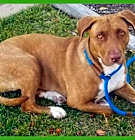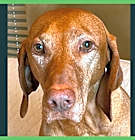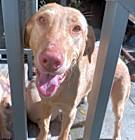Vizslas reach their full height between nine and 12 months of age. They will likely continue to fill out and develop muscle until they are around 18 months to two years old. Like many medium-sized breeds, Vizslas have a relatively rapid growth phase early in life, and their growth slows as they approach maturity.
Vizsla
Breed Type: Sporting
Common nicknames: Hungarian Vizsla, Velcro Dogs
Coat: Smooth
Hypoallergenic: No, they will likely trigger allergies.
Temperament: Intelligent, eager-to-please, independent, affectionate
Life expectancy: 12-15 years
Color & patterns: Red golden

Bursting with energy and an insatiable zest for life, Vizslas are athletic companions who are always ready for action. Bred for their hunting prowess and companionship, Vizslas were treasured by Hungarian nobility and served as trusted hunting companions. Their sleek and muscular builds, combined with their medium size (they typically stand at around 21 to 24 inches tall), allow them to excel in various activities, from sprinting alongside their humans to participating in agility courses. With their inquisitive and intelligent natures, Vizslas thrive on mental stimulation and are eager learners, making them a joy to train. But these pups are not all about work; these social butterflies also have a playful side that brings endless laughter and joy to their families, and they’re loyal and devoted family pets. With their velvety short coats and soulful eyes, Vizslas are also irresistible cuddle buddies who make a perfect fit for an active household.
Vizsla characteristics
Learn about about Vizsla basics like their fur colors, shedding levels, how much grooming they need, and other Vizsla facts.
Average height
21-25 inches (53.3-63.5cm)
Average weight
46-73 pounds (20.9-33.1 kg)
Average lifespan
12-15 years
Exercise needs
Grooming needs
Full-grown size
Good with cats
Good with kids
Training aptitude
What color are Vizslas?
Vizslas are varying shades of golden rust. This color can vary slightly from a lighter golden tan to a deeper reddish-brown shade. In terms of breed standards, the solid golden rust color is the most recognized and desired for Vizslas.
How big do Vizslas get?
Vizslas are medium-sized dogs, standing between 21 and 24 inches and weighing between 45 and 60 pounds, with males generally being larger than females. They have a lean and muscular build, which reflects their agility and endurance as hunting dogs.
Do Vizslas shed?
Yes, Vizslas shed. They are minimal shedders, though, and considered a low-maintenance breed in the grooming arena: just regular bathing will do right by this breed.
How fast can Vizslas run?
Vizslas can reach speeds of 25 to 40 miles per hour. This makes them quite fast compared to many other dog breeds, especially when they are sprinting or chasing after prey. Their agility and speed are reflective of their hunting heritage and their overall athleticism as a breed.
Vizsla temperament
Learn about about the Vizsla temperament and how well they fit into your lifestyle, home environment, and family.
Are Vizsla friendly?
Yes, Vizslas are friendly dogs. With their gentle and loving natures, Vizslas often form strong bonds with their families (sometimes they’re even called “velcro dogs”). Their friendly demeanor makes them good companions for families, children, and other pets, provided they are introduced and socialized appropriately. Pet parents should always supervise interactions between any dogs and kids to ensure that both the dog and the child understand how to behave appropriately around each other.
Are Vizslas good dogs?
Yes, Vizslas are excellent dogs. Their friendly and sociable temperaments make them great indoor and outdoor companions, and they enjoy participating in various activities with their families. Their athletic build and high energy levels make them well-suited for active lifestyles, whether it’s running, hiking, or playing. Vizslas need lots of daily mental stimulation and positive reinforcement.
Vizslas are cherished for their loving personalities, versatility, and ability to thrive as affectionate members of households who appreciate their energetic spirit and gentle nature. Vizslas have a strong desire for companionship, which makes them particularly devoted and affectionate canine companions.
Are Vizslas good with kids?
Yes, Vizslas are good with kids. With affectionate and gentle natures, Vizslas are excellent companions for families with children. They often form strong bonds with their human family members, including children, and enjoy being involved in family activities. Vizslas are usually patient and tolerant, especially when raised with children and properly socialized from a young age.
Like all dogs, Vizslas need to be trained to behave gently with children and vice-versa. Untrained Vizslas tend to “not know their own strength.” As with any dog breed, it’s essential to supervise interactions between Vizslas and young children to ensure mutual respect and safety.
Are Vizslas good with cats?
No, Vizslas may not be the best with cats as their hunting drive may cause them to chase the family cat. Of course, each dog (and cat) has their own preferences and temperament, and Vizslas are friendly and sociable dogs who, if introduced and socialized properly from a young age, can get along well with cats.
Are Vizslas good with other dogs?
Yes, Vizslas are good with other dogs thanks to their friendly and sociable personalities and playful and energetic natures. However, their compatibility with other dogs will depend on individual personalities, socialization, and the specific dynamics of the dogs involved. In general, though, Vizslas are dogs that enjoy the company of other dogs when introduced properly and socialized from an early age.
Do Vizslas bark a lot?
No, Vizslas don’t bark a lot. They tend only to bark when neglected for long periods of time as they crave human companionship and to alert their pet parents to potential threats or unfamiliar situations. As with any dog, they can be discouraged from barking as frequently with proper training and exercise. They are typically quiet and affectionate dogs that enjoy being close to their families, making them well-suited for households where excessive barking may be a concern.
Are Vizslas easy to train?
Yes, Vizslas are easy to train due to their keen intelligence, eagerness to please, and response to positive reinforcement. Like many smart breeds, Vizslas can exhibit a stubborn streak or independent behavior, especially if they become bored or if training sessions become repetitive. Providing mental stimulation and incorporating variety into training sessions can help keep them motivated and focused. Vizslas have a strong desire to work closely with their parents and enjoy learning new commands and tricks. Consistency, patience, and positive reinforcement are key when training a Vizsla.
Are Vizslas smart?
Yes, Vizslas are smart dogs. These quick learners have high-level problem-solving skills and great adaptability. Vizslas thrive on mental stimulation and interaction with their families, and their intelligence contributes to their ability to form strong bonds with their families and understand complex commands and tasks.
Are Vizslas good for first-time pet parents?
Yes, Vizslas are good for first-time pet parents committed to providing ample exercise, training, and attention. Vizslas are affectionate, intelligent dogs who thrive on companionship but require active engagement to channel their energy positively. Proper socialization and understanding their needs for mental stimulation are crucial for a successful bond with a Vizsla.
Are Vizslas good apartment dogs?
Vizslas can adapt to apartment living, but it’s not ideal for them. They are active dogs who require plenty of exercise and mental stimulation to stay happy and healthy. Apartments can work for Vizslas if their families are committed to providing regular outdoor activities such as long walks, runs, or visits to parks where they can run off-leash. Making sure they receive sufficient attention and playtime indoors is crucial to prevent boredom and destructive behaviors.
Do Vizslas like to swim?
Yes, Vizslas like to swim. They have a natural affinity for water and are strong swimmers thanks to their athletic builds and webbed feet.
However, like all dogs, individual preferences can vary. Some Vizslas may need encouragement or a gradual introduction to water, especially if they haven’t been exposed to it early in life. With positive experiences and encouragement, Vizslas can become enthusiastic swimmers and enjoy activities like retrieving toys or playing in the water. Supervision is important, especially in unfamiliar bodies of water, to ensure their safety.
When do Vizslas calm down?
Vizslas calm down as they mature, around one to two years of age. During their puppy and adolescent stages, Vizslas have high energy levels and exuberant behavior. As they reach adulthood, they often become more settled and less hyperactive. Providing positive outlets for their energy through long walks, runs, and play sessions helps to channel their natural vigor. Additionally, continued socialization and training can contribute to their overall behavior and temperament, helping them to become well-adjusted and more relaxed companions.
Vizsla health
Learn about about the Vizsla health outlook and what diseases they may be prone to at various stages of their life.
Do Vizslas have their tails docked?
Traditionally, Vizslas have had their tails docked. Docking is a practice where a portion of a dog’s tail is surgically removed shortly after birth. Historically, this was done to prevent tail injuries during hunting or working activities. In recent years, however, there has been a shift away from tail docking that reflects broader societal changes toward more humane and ethical treatment of animals, including dogs. Many veterinarians and veterinary organizations discourage unnecessary surgeries like tail docking unless there is a compelling medical reason, such as injury or disease.
Are Vizslas healthy?
Vizslas are mainly very sturdy, robust dogs but can be prone to diseases, including:
Hip and/or elbow dysplasia: Hip and elbow dysplasia are two of the most common skeletal diseases seen in dogs. They are similar diseases in which either the hip or elbow joint has grown abnormally or is misshapen. The abnormal shape prevents the joints and sockets from properly meeting one another, resulting in rubbing and grinding instead of sliding smoothly. Unlike in hip dysplasia, where the main problem is joint instability, the abnormalities seen in elbow dysplasia often result in pieces of bone and/or cartilage breaking loose and irritating the joint tissues. Over time, the rubbing from dysplasia can cause a variety of issues, such as pain, lameness, and secondary osteoarthritis. Surgery can be done to fix the joint if diagnosed before the onset of arthritis. If you are rescuing a Vizsla, have them checked out by a vet to see if they have or are prone to getting dysplasia so you know what they will be able to handle in terms of activities and exercise.
Lymphoma or lymphosarcoma: Lymphoma is a blanket term used to describe cancers that originate in white blood cells called lymphocytes. They are most commonly found in the lymph nodes, bone marrow, and spleen. There are more than 30 types of lymphoma that affect dogs, and they vary in aggressiveness, treatment, and symptoms. Because the symptoms of lymphoma are so varied, it can be difficult to diagnose. The best way to make sure your dog receives treatment is to keep an eye on her behavior and take her to the vet when something seems off or she appears to be in pain. The most common treatment for lymphoma is chemotherapy.
Others: Gastric dilatation-volvulus, a potentially fatal bloating of the abdomen; progressive retinal atrophy, a progressive degenerative disease affecting the retina that eventually leads to blindness; epilepsy; hypothyroidism, a thyroid malfunction that results in low hormone production; and skin allergies. To identify some of these issues, a veterinarian may recommend hip and imaging tests for the dog. When given the proper diet and exercise, many of these issues can be kept at bay.
Are Vizslas prone to cancer?
Yes, unfortunately, Vizslas have a higher incidence of cancer compared to other breeds. Several types of cancer, including mast cell tumors, lymphoma, and hemangiosarcoma, are more common in Vizslas. The reasons for this susceptibility to cancer in Vizslas are not entirely understood but may involve genetic predispositions or environmental factors.
To help mitigate the risks of cancer, responsible breeding practices and health screenings are important. Regular veterinary check-ups and early detection through screenings can also improve outcomes if cancer is detected. Additionally, providing a healthy diet, regular exercise, and minimizing exposure to potential carcinogens can contribute to overall wellness and reduce the risk of cancer in Vizslas.
Are Vizsla prone to liver disease?
No, Vizslas are not specifically prone to liver disease. However, like all dogs, they can develop liver issues due to various factors such as genetics, infections, toxins, or other underlying health conditions.
Common liver conditions that may affect Vizslas (and dogs in general) include hepatitis (inflammation of the liver), liver shunts (congenital abnormalities affecting blood flow through the liver), and liver tumors. Symptoms of liver disease in dogs can include lethargy, jaundice (yellowing of the eyes and skin), vomiting, diarrhea, and changes in appetite or weight.
If a Vizsla shows signs of liver disease, prompt veterinary attention is crucial for accurate diagnosis and appropriate treatment. Early detection and management can help improve outcomes and maintain the dog’s quality of life.
Are Vizslas hypoallergenic?
No, Vizslas are not hypoallergenic. They have a short and smooth coat that sheds moderately throughout the year. While they do not typically have a dense undercoat like some breeds, they still shed dander (dead skin cells) and produce saliva and urine proteins that can trigger allergic reactions in sensitive individuals.
People with dog allergies should consult an allergist before bringing a Vizsla or any other breed into their home. Regular grooming, such as brushing and bathing, can help reduce the amount of loose hair and dander in the environment, which may help minimize allergy symptoms. However, Vizslas are not hypoallergenic dogs (no dog breed is) and may not be suitable for individuals with severe allergies to dogs.
Vizsla history
Learn about where this Vizsla came from!
Where are Vizslas from?
Vizslas are from Hungary. They hunted with the Magyar nomads of Hungary over a thousand years ago and became the favored companions and hunting aids of Hungarian aristocrats during the 18th and 19th centuries. They were introduced to the U.S. in the 1950s.
What are Vizslas bred for?
Vizslas are primarily bred for hunting and retrieving game, particularly birds. They are versatile hunting dogs who excel in various environments, including forests, fields, and water. Their keen sense of smell, agility, and ability to work closely with hunters make them prized companions for hunting enthusiasts. Loyal, loving Vizslas also make excellent family pets and companions.
How many types of Vizslas are there?
There is only one type of Vizsla. Wire-haired Vizslas are similar to Vizslas but are considered a separate breed from the Vizsla, also known as the Hungarian Vizsla.
How long do Vizslas live?
Vizslas live between 12 and 14 years. Like all breeds, individual lifespans can vary based on factors such as genetics, diet, exercise, and overall health care. Providing proper nutrition, regular exercise, veterinary care, and a loving environment can contribute to a longer and healthier life for Vizslas.
Is a Vizsla a hound?
No, a Vizsla is not a hound. Vizslas belong to the sporting dog group. They are specifically classified as pointer dogs with keen hunting instincts and excellent ability to locate and point out game, especially birds. Hounds, on the other hand, are a different group of dogs primarily bred for hunting by scent and were historically used for tracking game.
Are Vizslas and Weimaraners related?
No, Vizslas and Weimaraners are not closely related in terms of their breed origins. They are distinct breeds with different histories and characteristics. Unlike the Hungarian Vizslas, Weimaraners are from Germany. They were bred as versatile hunting dogs as well, specifically for hunting large game like deer, boar, and bear. Weimaraners have a distinctive silver-gray coat, while Vizslas are rust-colored.
Popular Vizsla mixes
Characteristics of Vizsla mixes can vary widely depending on the specific breeds involved, the individual dog’s genetics, and upbringing. A few common Vizsla mixes include:
Labralas (Vizsla + Labrador Retriever)
Transylvizsla Hound (Vizsla + Transylvanian Hound)
Vizmaraner (Vizsla + Weimaraner)
Vizsla Staff (Vizsla + American Staffordshire Terrier)

Find Vizsla puppies near you
Adopting a Vizsla
Learn about acquiring a Vizsla - the pros and cons of adopting versus going through a breeder, and associated costs.

Dakota
Vizsla Pit Bull Terrier
Female, 9 yrs 10 mos
Los Angeles, CA
Good with dogs
Not good with cats
House-trained
Spayed or Neutered
Shots are up-to-date

Harrison
Vizsla
Male, 7 yrs 3 mos
Los Angeles, CA
Not good with dogs
Not good with cats
House-trained
Spayed or Neutered
Shots are up-to-date

Luke
Vizsla Labrador Retriever
Male, young
Marina Del Ray, CA
Good with dogs
Not good with cats
House-trained
Spayed or Neutered
Shots are up-to-date

Dakota
Vizsla Pit Bull Terrier
Female, 9 yrs 10 mos
Los Angeles, CA
Good with dogs
Not good with cats
House-trained
Spayed or Neutered
Shots are up-to-date

Harrison
Vizsla
Male, 7 yrs 3 mos
Los Angeles, CA
Not good with dogs
Not good with cats
House-trained
Spayed or Neutered
Shots are up-to-date

Luke
Vizsla Labrador Retriever
Male, young
Marina Del Ray, CA
Good with dogs
Not good with cats
House-trained
Spayed or Neutered
Shots are up-to-date
